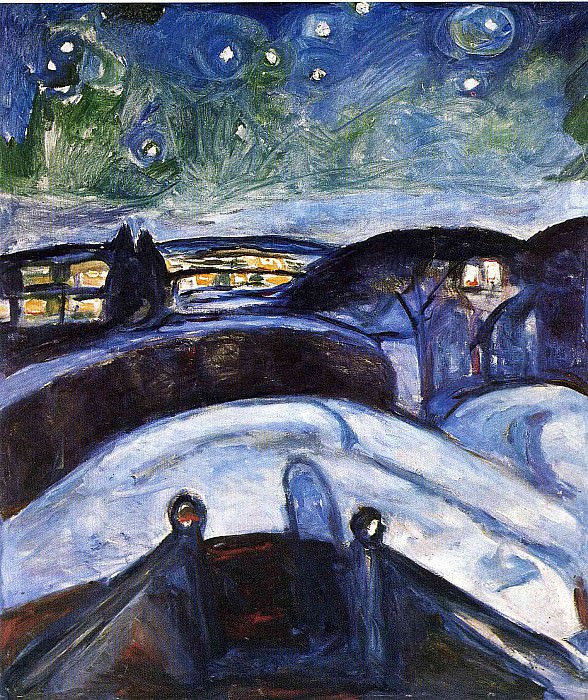img752 Edvard Munch (1863-1944)
Edvard Munch – img752
Edit attribution
Download full size: 1419×1692 px (0,3 Mb)
Painter: Edvard Munch
The stars have always attracted Munch, serving as a mysterious object of his creative worship. He painted several paintings united by a common theme. One of them is Starry Night. More precisely, not just one, there were several. Munch had one peculiarity - to paint his canvases in different variations. Such was the case with this painting. "Starry Night," 1922, is depicted on a moonlit winter night.
Description of Edvard Munch’s painting "Starry Night"
The stars have always attracted Munch, serving as a mysterious object of his creative worship. He painted several paintings united by a common theme. One of them is Starry Night. More precisely, not just one, there were several. Munch had one peculiarity - to paint his canvases in different variations. Such was the case with this painting.
"Starry Night," 1922, is depicted on a moonlit winter night. This view was familiar to the artist, as it is the sky from the window of his home. But this did not diminish Munch’s love of the mysterious starry sky.
This is expressed in the way the author paints the details of his work: snowdrifts underfoot are marked carelessly, without special care, while the sky with shimmering stars captures the eye completely.
At the same time, Munch does not seek solitude. He fills the painting with light coming from the windows of distant houses, which adds some warmth to the subject. It blends with the moonlight, and this fusion is the basis of ghostliness and mystery.
The predominant blue color and bright green explosions in the night sky add vividness and emotional openness to the work.
One can feel that the painter didn’t strive for brightness of emotions when painting the world around him. Rather it reeks of calmness and sincerity, makes you think deeply about the strangeness of life. Despite the apparent simplicity and the childish manner of painting, the true connoisseur understands that the picture is made by the hand of a master, a professional and genius.
All his life Munch, according to the words of his contemporaries, belonged only to art. His personal life did not work out. In addition, after a number of failures, Munch suffered from depressive psychosis, from which he was treated for a long time in a specialized hospital. Munch’s talent was certainly recognized, despite his state of mind. The artist died in his own chair with a volume of Dostoevsky in his hands.
Кому понравилось
Пожалуйста, подождите
На эту операцию может потребоваться несколько секунд.
Информация появится в новом окне,
если открытие новых окон не запрещено в настройках вашего браузера.
You need to login
Для работы с коллекциями – пожалуйста, войдите в аккаунт (open in new window).




















You cannot comment Why?
The painting depicts a nocturnal landscape with a swirling, celestial display of stars and possibly the aurora borealis. The sky is a deep, rich blue transitioning into vibrant greens, filled with luminous, halos of white and yellow stars that seem to pulse with energy. Below this dramatic sky, rolling hills covered in snow recede into the distance.
On these hills, several isolated houses with warmly lit windows break the darkness, suggesting human habitation and a stark contrast between the cozy interiors and the vast, wild expanse of the night. In the foreground, a snow-covered path or road leads upwards, with two silhouetted figures walking or standing on it. They are rendered in dark, indistinct forms, adding a sense of anonymity and introspection to the scene.
The brushstrokes are expressive and energetic, contributing to the overall feeling of movement and intensity. The colors are bold and contrasting, with the blues and greens of the night sky and landscape juxtaposed against the warm yellows of the windows.
The subtexts of the painting can be interpreted in several ways:
Overall, the painting seems to capture a moment of intense atmospheric and emotional experience, where the external landscape becomes a canvas for the artists inner feelings about nature, humanity, and existence.